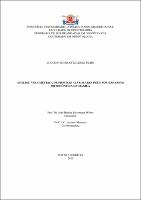| Compartilhe o registro |


|
Use este identificador para citar ou linkar para este item:
https://tede2.pucrs.br/tede2/handle/tede/6044| Tipo do documento: | Tese |
| Título: | Análise volumétrica de fissuras alveolares pré e pós-expansão ortodôntica da maxila |
| Autor: | Lessa Filho, Luciano Schwartz  |
| Primeiro orientador: | Weber, João Batista Blessmann |
| Primeiro coorientador: | Menezes, Luciane |
| Resumo: | A reabilitação de pacientes com fissura labiopalatinas pode ser mais eficiente quando o volume da fissura alveolar é obtido através de imagens de Tomografias Computadorizadas. Por isso, esse trabalho objetivou avaliar possíveis alterações volumétricas em fissuras alveolares de pacientes com fissuras labiopalatinas unilaterais antes e depois da expansão ortodôntica da maxila, através de imagens de tomografia computadorizada de feixe cônico (TCFC). O trabalho foi desenvolvido utilizando-se o banco de dados do Centro de Reabilitação de Fissura Labiopalatina (CERLAP) da Faculdade de Odontologia da PUCRS. Vinte e seis pacientes com fissura labiopalatina unilateral foram avaliados no período pré-expansão (T1) e pós-expansão da maxila (T2) com duas avaliações (AV1 e AV2) em cada período, feitas pelo mesmo examinador. O software utilizado para a mensuração foi o OsiriXMD MD. As médias antes e depois do procedimento (T1 e T2) e as médias das avaliações (AV1 e AV2) foram comparadas através do teste t-Student para amostras pareadas ao nível de 5% de probabilidade de erro. Para comparar o volume entre os gêneros e as faixas etárias, aplicou-se o teste t-Student para amostras independentes. Utilizou-se o método de Bland-Altman com limites de 95% na avaliação das concordâncias entre AV1 e AV2, que comprovou o alto grau de reprodutibilidade do método proposto com 92% (24 de 26 medidas) de concordância entre as medições realizadas nos dois tempos. A correlação de Pearson em T1 teve r=0,94 e em T2 r=0,88. O volume médio na AV1 e AV2 foi 1,10±0,48 e 0,98±0,46 cm3, respectivamente, sendo que tanto na AV1 quanto na AV2 observou-se que as fissuras em T2 apresentaram maior volume do que as fissuras em T1 (p=000). As médias em T1 e T2 foram 0,86±0,37 e 1,21±0,57 cm3, respectivamente, sendo a diferença de aproximadamente 41% em relação à T1. O volume da fissura alveolar não diferiu entre os gêneros, faixas etárias e lados da fissura. Concluiu-se que o software OsiriXMD possui alto grau de reprodutibilidade para delimitar a fissura alveolar e mensurar o seu volume com o uso de imagem de TCFC, e que o volume da fissura alveolar aumenta consideravelmente após a expansão da maxila. |
| Abstract: | The rehabilitation of patients with lip and palate cleft can be more efficient when the volume of the alveolar cleft is obtained through Computered Tomography (CT) scans. Therefore, this work aimed to evaluate the volume of alveolar cleft in patients with unilateral lip and palate cleft before and after the orthodontic maxillary expansion by Cone-Beam Computed Tomography scans (CBCT). The study was conducted using the database of the Rehabilitation Center of Lip and Palate Cleft (CERLAP) at PUCRS Faculty of Dentistry. 26 patients were assessed during pre-expansion period (T1) and after the maxillary orthodontic expansion (T2) with two reviews (AV1 and AV2) in each period, performed by the same examiner. The software used for the measurement was the OsiriX MD. The average before and after the operation (T1 and T2) and the average of reviews (AV1 and AV2) were compared using the Student t test for paired samples at 5% of probability. To compare the volume between genders and age groups, we applied the Student t test for independent samples. We used the Bland-Altman method with limits of 95% in the evaluation of concordance between AV1 and AV2, which confirmed the high degree of reproducibility of the proposed method with 92% (24 of 26 measures) agreement between the measurements performed in the two periods. The Pearson correlation at T1 was r = 0.94 and r = 0.88 at T2. The average volume on AV1 and AV2 was 1.10 ± 0.48 and 0.98 ± 0.46 cm3, respectively, and both in the AV1 and AV2 it was observed that clefts on T2 had greater volume than the clefts on T1 (p = 000). The average on T1 and T2 were 0.86 ± 0.37 and 1.21 ± 0.57 cm3, respectively, with the difference being about 41% compared to T1. The volume of the alveolar cleft did not differ between genders, age groups and sides of the cleft. It was concluded that the software OsiriXMD has a high degree of reproducibility to delimit the alveolar cleft and measuring its volume with the use of CBCT image. |
| Palavras-chave: | ODONTOLOGIA ORTODONTIA TOMOGRAFIA COMPUTADORIZADA DE FEIXE CÔNICO FISSURA LABIOPALATAL ORTOPEDIA MAXILAR |
| Área(s) do CNPq: | CIENCIAS DA SAUDE::ODONTOLOGIA |
| Idioma: | por |
| País: | Brasil |
| Instituição: | Pontifícia Universidade Católica do Rio Grande do Sul |
| Sigla da instituição: | PUCRS |
| Departamento: | Faculdade de Odontologia |
| Programa: | Programa de Pós-Graduação em Odontologia |
| Tipo de acesso: | Acesso Aberto |
| URI: | http://tede2.pucrs.br/tede2/handle/tede/6044 |
| Data de defesa: | 31-Mar-2015 |
| Aparece nas coleções: | Programa de Pós-Graduação em Odontologia |
Arquivos associados a este item:
| Arquivo | Descrição | Tamanho | Formato | |
|---|---|---|---|---|
| 469177 - Texto Completo.pdf | Texto Completo | 1,25 MB | Adobe PDF |  Baixar/Abrir Pré-Visualizar |
Os itens no repositório estão protegidos por copyright, com todos os direitos reservados, salvo quando é indicado o contrário.




